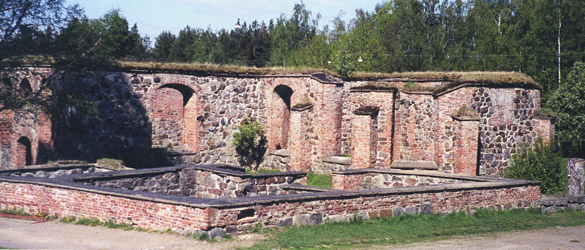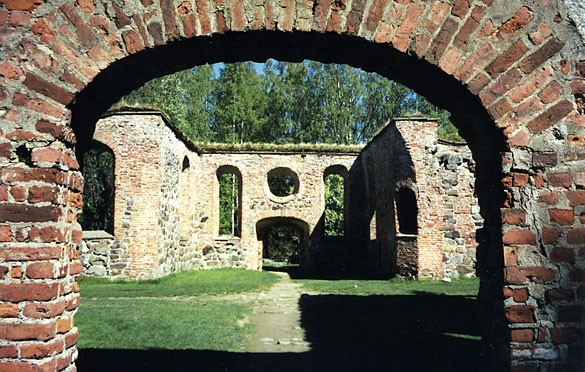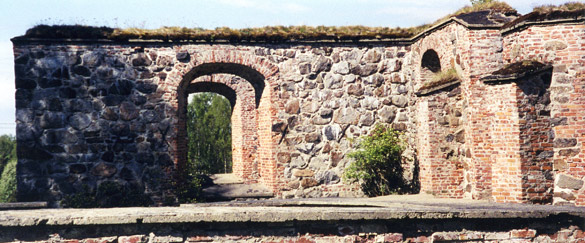on ruins



Long-time blog friend Lucy of Box Elder writes wonderful posts from her home in Brittany. I love her rambling stories and gorgeous photos of her garden and the world she lives in, of forays to explore many interesting towns and historical sites. They touch something deep in me, a love for the ancient, the traces of the past, the weathering actions of time and nature. Maybe it's because I live in such a young city and province in the New World. Today Lucy wrote about her visit to Château de la Hunaudaye, a medieval fortress that has been restored.
This inspired me to pull out a photo album from May and June 2002, from a trip to Vaasa, Finland. Two artist friends and I had an exhibition of our prints there, in fact called Traces. We spent several days in Vaasa hanging our exhibition, having a meeting with the press, visiting family, printmakers and exploring the city and surrounds. All culminating in the opening of course.
One interesting place we visited was Old Vaasa, at the site of the original city that had burned down, and its ruins of St. Maria Church. Sadly my photographs are not good - here's a better photo. Like the Château, these ruins had also been restored in part, minus the roof. Lucy lamented how restorations sometimes destroy the character of the original, something I'd agree with from my comparatively limited exposure. Much as I liked these simple church ruins and commend that it was done, it lacked some of that very old, crumbling, decaying quality. It is a quandary indeed, to restore or not and to do it sensitively, to save our history or not.
Marja-Leena | 20/08/2012 | 15 comments
themes: History, Rock Art & Archaeology

Marja-Leena,
I recognised the ruins at once. I've been living in Vaasa for over 15 yrs and I have often visited the ruins.
Off and on there is talk in the city if the church ruins should be covered with a roof, because weather eats the tiles all the time. There is sometimes concerts or children's plays or something in the the ruins, but nothing all the time. So the roof might be good for using the space.
On the other hand, it might RUIN the ruins. The city father's and mother's would not know beforehand.
Hei Ripsa! As a resident of Vaasa, I was thinking of you and hoping you would comment. Kiitos! The city fathers and mothers have a difficult decision to make. Somehow to me, adding a roof would make it no longer a ruin. It would require tremendous skill and sensitivity, but where to get the old roofing materials, or how to replicate that aged look?
"Finding a spiritual connection between ancient and modern, and between nature, technology and humans, is part of my journey of discovery towards a fundamental and personal view of existence, a sense of eternity."
I just read this at your 'Traces' exhibit page and found it to be a sentiment I can well share. Your pictures of the ruin at Vaasa and Lucy's Chateau are both magnificent. Isn't it funny how the remains of ancient architecture always remind us of kinder and gentler times even if we're looking at what may have been dungeons? I remember best the ruins of Norman churches in England as places evoking a sense of spirituality between earth and sky. It seems to me that humanity isn't naturally fearful of the unknown.
Susan, I'm so very pleased you looked at the 'Traces' site and like my statement. I still like it and still feel that way.
Yes, it is strange how ruins fascinate us. Ruins of churches would particularly evoke the spiritual, as you say, but what about castles and palaces, places of former wealth? I've been reading several historical fictions and one biography this summer so I'm really conscious again of how brutal our past history has been. Has anything really changed, I often wonder?
I do love ruins as well as good restorations, and one's Romantic sensibilities come roaring to the fore in a fine ruin. But sometimes I look out over the lake and low mountains and Kingfisher Tower and think that some day the Tower will fall into the lake, and the lake will vanish and even the mountains--that hills will be laid low, and low places lifted up. And all our little scratchings on the cave wall, what of them? Life is full of creation and destruction, and what can we do but create and rejoice...
I share your prejudice against restorations. I love ruins. Maybe I identify with them at my age (;
I like your photos better than the one you linked to. They are soothing.
Marly, Romantic sensibilities as well as knowing everything is finite on this earth sound like a contradiction, but how right you are!
Hattie, glad you like the photos. About identifying with them at our age, you shouldn't and I'm not ready to admit it yet. :-)
What about other ruins - say German cities after WWII bombings. Should they have saved all these ruins, a a few "representative" ruins, or none?
Where on the continuum of decay do you want the try and stop - as the ruins are now, what they were like when built, 100 years ago?
"ET", though I wish you'd given me your name, I think that's an excellent question. My sense would be that certain culturally important buildings be saved but obviously not all can be saved such as huge areas that have been flattened like in many German cities. I recall the ruins of a church in Berlin that was left as a memorial, the Kaiser Wilhelm Gedachtniskirche, where a new section was added.
As for your second question, I don't know, it would depend on the site perhaps. What is your opinion?
It seems the main thing that's changed is scale.. and the fact that the world's wealthiest can build castles anywhere.
Susan, I agree.
Just got round to seeing these ruins. My memories of Finland are invariably of wonderful modern building. I am always drawn to ruins, a sense of fellow feeling nowadays.
Joe, yes, I think Finland's modern architecture is well known. Sounds like you've been there, I didn't know! I'm not sure there are many ruins in existence, because wood construction was much more prevalent. I think there are only a very few old stone churches, some restored and in use. I would need to research that.
I don't think you need to think of yourself feeling like a ruin, Joe! As I recall you are in great shape. I, on the other hand, with my knees...
Thanks for the link and the kind words, ML, sorry to be so late to comment, I somehow missed this on my feeds.
Old stones and ruins are not something I associate with Finland either, so this is a revelation.
I suppose all ruins have their own particular story, including how they came to be ruins; often the sadness and melancholy, or indeed sometimes outrage, that they provoke are to do with this. Rose Macauley (who once lived in Clive HJ's house in Wales!) wrote a book called 'Pleasure of Ruins', which I understand explores many of these ideas and feelings at great length and depth, and came in part out of her experience of destruction and violent ruination of the Second World War. I haven't actually read it but now feel inspired to!
Lucy, you certainly inspired some thinking about ruins. I think for me, it is the many centuries old ruins which appeal the most, more from an archaeological perspective I suppose, more than those from the past 100 years. I suddenly recall coming across a then-recently discovered ancient site west of Rome that was being excavated and partly restored. Another post, maybe?
Rose Macauley's book does sound like an interesting one to read.